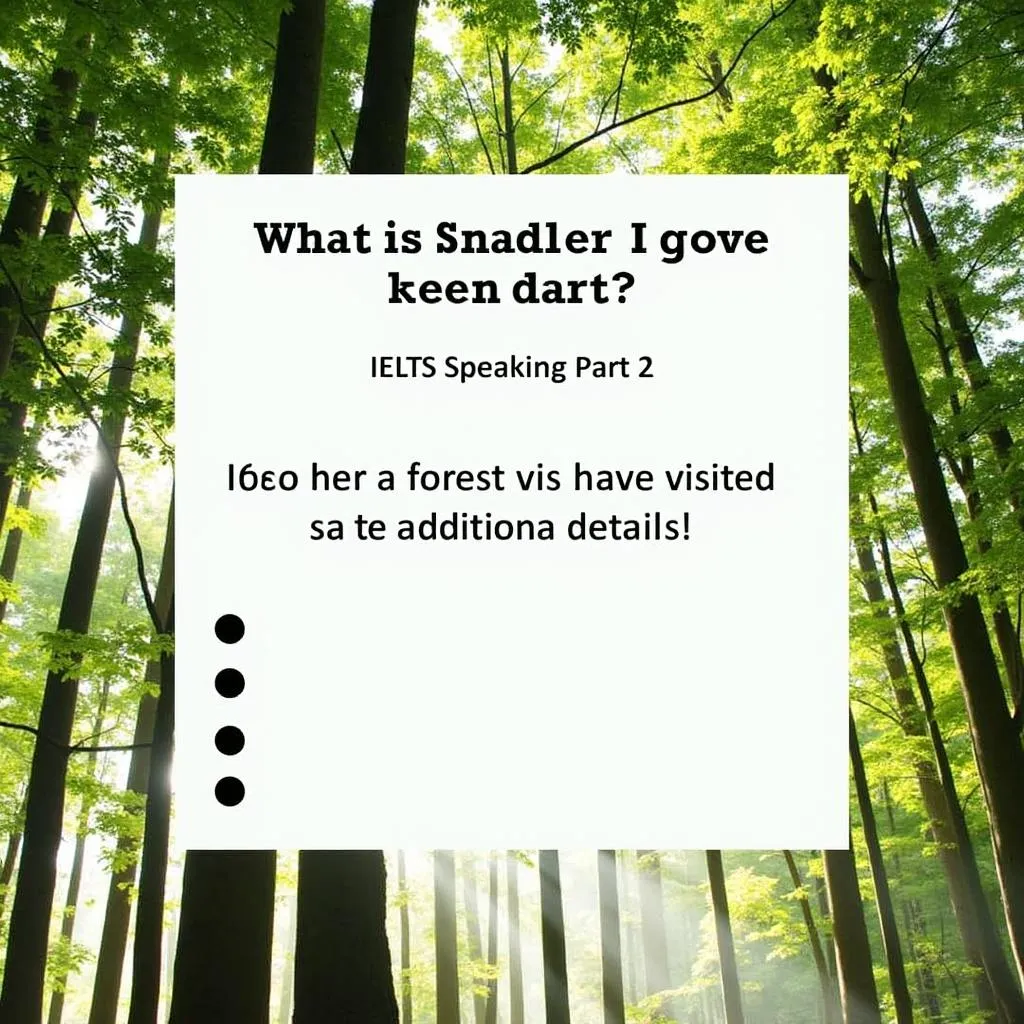IELTS Speaking exams often include questions about nature and outdoor experiences. One popular topic is describing a forest you have visited. This article will guide you through answering such questions effectively, helping you achieve a high score in your IELTS Speaking test.
Part 1: Introduction and Interview
In this section, the examiner may ask you general questions about forests and nature. Here are some common questions and sample answers:
- Do you like visiting forests?
- How often do you go to forests?
- What activities do you enjoy doing in forests?
Let’s focus on the first question:
Examiner: Do you like visiting forests?
Band 6-7 Answer:
Yes, I do enjoy visiting forests. They’re peaceful and beautiful places where I can relax and enjoy nature. I find it refreshing to be surrounded by trees and breathe in the fresh air.
Band 8-9 Answer:
Absolutely! I’m particularly fond of forest visits. There’s something truly captivating about being immersed in nature, surrounded by towering trees and the rich biodiversity of the forest ecosystem. I find it not only rejuvenating but also intellectually stimulating as it allows me to observe and learn about various flora and fauna in their natural habitat.
Part 2: Long Turn
In this section, you’ll be given a cue card with a topic to speak about for 1-2 minutes. Here’s a sample cue card related to describing a forest:
 IELTS Speaking Cue Card for Describing a Forest
IELTS Speaking Cue Card for Describing a Forest
Describe a forest you have been to and what you enjoyed about it
You should say:
- Where the forest is located
- When you visited it
- What you did there
- And explain why you enjoyed visiting this forest
Band 6-7 Answer:
I’d like to talk about a forest I visited last summer. It’s located in the northern part of my country, about a three-hour drive from my hometown. The forest is quite large and known for its diverse plant and animal life.
I went there with my family for a weekend trip. We spent most of our time hiking on the well-marked trails. It was really nice to walk under the tall trees and hear the birds singing. We also saw some small animals like squirrels and rabbits.
One of the things I enjoyed most was the peaceful atmosphere. It was so quiet compared to the city, and the air felt really fresh and clean. We had a picnic in a clearing, which was fun. The scenery was beautiful, especially when we reached a high point and could see the forest stretching out below us.
I enjoyed this visit because it was a great chance to relax and connect with nature. It made me realize how important it is to preserve these natural areas. The experience was refreshing and helped me feel recharged after being in the city for so long.
Band 8-9 Answer:
I’d be delighted to describe a remarkable forest I had the pleasure of visiting last autumn. This awe-inspiring woodland is situated in the heart of the Carpathian Mountains in Romania, a region renowned for its pristine wilderness and rich biodiversity.
My expedition to this enchanting forest took place during a research trip I participated in as part of my environmental studies. We spent a week immersing ourselves in the forest ecosystem, conducting various scientific observations and data collection activities.
Our days were filled with fascinating endeavors. We meticulously cataloged plant species, set up camera traps to observe wildlife, and even had the extraordinary opportunity to participate in a wolf tracking program. The highlight of our visit was undoubtedly when we stumbled upon a family of brown bears foraging for berries – a truly breathtaking sight that left us all in awe of nature’s majesty.
What made this forest visit particularly enjoyable and memorable was the profound sense of connection with the natural world it fostered. The ancient beech trees, some over 500 years old, seemed to whisper centuries of wisdom, while the crystal-clear mountain streams provided a soothing soundtrack to our explorations. The sheer biodiversity we encountered, from rare orchids to elusive lynx, served as a powerful reminder of the intricate web of life that thrives in undisturbed ecosystems.
Moreover, the experience was intellectually stimulating, allowing me to apply theoretical knowledge in a practical setting and gain invaluable insights into forest ecology and conservation. It reinforced my passion for environmental protection and left an indelible mark on my perspective of our relationship with nature.
In essence, this forest visit was not just enjoyable but truly transformative, blending scientific discovery with a deep appreciation for the raw beauty and vital importance of our planet’s wild places.
Examiner: What do you think are the main threats to forests like the one you visited?
Band 6-7 Answer:
I believe the main threats to forests like the one I visited are things like deforestation for timber or agriculture, and climate change. These can harm the plants and animals living there. Pollution is also a problem, as it can damage the forest ecosystem.
Band 8-9 Answer:
The forests I visited, like many others worldwide, face a multitude of interconnected threats. Foremost among these is large-scale deforestation driven by agricultural expansion, logging, and infrastructure development. This not only decimates habitats but also fragments remaining forest patches, making them less resilient.
Climate change poses an insidious threat, altering temperature and precipitation patterns, which can lead to increased frequency and severity of wildfires, pest outbreaks, and shifts in species distributions. Moreover, the synergistic effects of climate change and habitat loss can exacerbate biodiversity loss.
Another significant concern is the introduction of invasive species, which can outcompete native flora and fauna, disrupting delicate ecological balances. Additionally, unsustainable tourism practices, if not properly managed, can lead to soil erosion, disturbance of wildlife, and degradation of natural habitats.
Lastly, we shouldn’t overlook the indirect impacts of global consumption patterns and unsustainable resource use, which drive many of these direct threats. Addressing these challenges requires a holistic, multi-faceted approach to forest conservation and sustainable development.
Part 3: Two-way Discussion
In this section, the examiner will ask more abstract questions related to the topic. Here’s an example:
Examiner: How do you think we can encourage more people to appreciate and protect forests?
Band 6-7 Answer:
I think we can encourage people to appreciate and protect forests by educating them about the importance of these ecosystems. Schools could organize field trips to forests, and there could be more nature documentaries on TV. Governments could also create more national parks and protected areas. Maybe we could have campaigns to plant more trees in cities, so people can see the benefits of having green spaces around them.
Band 8-9 Answer:
Encouraging greater appreciation and protection of forests requires a multi-faceted approach that addresses both education and engagement. Firstly, we need to enhance environmental education at all levels, from primary schools to universities and adult learning programs. This should include not just theoretical knowledge but also experiential learning through field trips and citizen science projects that allow people to directly interact with forest ecosystems.
Secondly, we should leverage technology to make forests more accessible and engaging. This could involve developing interactive apps that guide users through forest trails, providing information about flora and fauna, or creating virtual reality experiences for those unable to visit forests physically. Social media campaigns showcasing the beauty and importance of forests could also help reach a wider audience.
Furthermore, policy measures are crucial. Governments should incentivize forest conservation through tax breaks or subsidies for landowners who maintain forested areas. Urban planning should prioritize the integration of green spaces and mini-forests within cities, making nature more accessible to urban dwellers.
Lastly, we need to highlight the interconnectedness between human well-being and forest health. This includes emphasizing the role of forests in climate regulation, water purification, and even public health. By demonstrating how forest conservation directly benefits individuals and communities, we can foster a sense of personal stake in forest protection.
Ultimately, cultivating a deeper connection between people and forests, through a combination of education, experience, policy, and demonstrating relevance, is key to encouraging widespread appreciation and protection of these vital ecosystems.
Key Vocabulary and Phrases for High Scores
To achieve a high score in IELTS Speaking, especially when describing a forest, consider using these advanced words and phrases:
-
Biodiversity /ˌbaɪəʊdaɪˈvɜːsəti/ (noun): The variety of plant and animal life in a particular habitat.
Example: The forest’s rich biodiversity includes numerous species of birds, mammals, and insects. -
Ecosystem /ˈiːkəʊˌsɪstəm/ (noun): A biological community of interacting organisms and their physical environment.
Example: The forest ecosystem is complex, with each species playing a vital role. -
Canopy /ˈkænəpi/ (noun): The uppermost layer in a forest, formed by the crowns of the trees.
Example: Sunlight filtered through the dense canopy, creating dappled shadows on the forest floor. -
Pristine /ˈprɪstiːn/ (adjective): In its original condition; unspoiled.
Example: We were amazed by the pristine beauty of the ancient forest. -
Lush /lʌʃ/ (adjective): Growing luxuriantly; very rich and providing great sensory pleasure.
Example: The forest was incredibly lush, with vibrant green foliage everywhere we looked.
 Lush Green Forest Canopy
Lush Green Forest Canopy
Examiner’s Advice
To excel in describing a forest during your IELTS Speaking test:
- Use a variety of descriptive adjectives to paint a vivid picture.
- Incorporate personal experiences and emotions to make your answer more engaging.
- Discuss both the visual aspects and other sensory experiences (sounds, smells) of the forest.
- Include some discussion about the importance of forests for the environment and biodiversity.
- Practice speaking about different types of natural environments to broaden your vocabulary.
Remember, the key to a high score is not just about using advanced vocabulary, but also about speaking fluently, coherently, and with genuine enthusiasm about the topic.
Describe a family trip you enjoyed can be another interesting topic to practice, as it shares some similarities with describing a forest visit in terms of expressing personal experiences and emotions.
By following these guidelines and practicing regularly, you’ll be well-prepared to tackle any question about forests or natural environments in your IELTS Speaking test. Good luck with your preparation!


